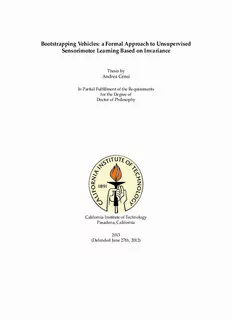
Bootstrapping Vehicles - Andrea Censi's website PDF
Preview Bootstrapping Vehicles - Andrea Censi's website
Bootstrapping Vehicles: a Formal Approach to Unsupervised Sensorimotor Learning Based on Invariance Thesisby AndreaCensi InPartialFulfillmentoftheRequirements fortheDegreeof DoctorofPhilosophy CaliforniaInstituteofTechnology Pasadena,California 2013 (DefendedJune27th,2012) Dedication Iwishtodedicatethisworktomyparents,RitaandPino,asapartialrepayment of their sizable investment in Lego pieces 30 years ago, which ultimately led to my interest in robotics; and to my brother Marco, who bore the burden of being my first office mate. I am deeply indebted to my parents as they taught me to ask questions, and to question answers. They are a model of moral integrity and hushedselflessnessthatIhopeIwillhavethestrengthtoemulate. i Acknowledgments TheseyearsatCaltechhavebeenanexcitingroller-coaster,whichbeganslowly, wentthroughfreneticupsanddowns,andendedmuchtooquickly. IwishIcould buyaticketforanotherride. I will always be indebted to my advisor Richard Murray, who was the main reasonforthistobearelativelypleasantandfulfillingexperience. Hehasbeenthe lastofalongseriesofpeoplewhomIwasluckytomeetfromhighschooltograd- uateschool,whotaughtmethevalueofintellectualhonesty,howtorespectmyself andothers,and,ofequalimportance,howtogetthingsdone,withoutcompromise. Theyencouragedmetoexploretheroadlesstraveled,theyguidedmethroughthe clouded waters of failure and uncertainty, and helped me enjoy the eventual suc- cesses. Their advice has been heard and preciously guarded, even when I did not followit. Iwillalwaysfeeltheireyesonme,and,asIwalkalone,theirmemorywill keepmychinupandmypathstraight. Myrepaymenttothemisthecommitment to put the same effort and dedication towards guiding the people who will come afterme. DuringmyyearsatCaltech,IhadtheprivilegeofworkingwithMichaelDick- inson and Andrew Straw, who made me realize that, after all, biologists might be smarterthanengineers,andwithStefanoSoatto,whomIthankforhisfrankadvice and honest critiques. I thank Joel Burdick and Yaser Abu-Mostafa for their advice andforservingonmythesiscommittee. Ithankmygeographicallyuniformlydis- tributed co-authors Shuo Han, Sawyer Fuller, Davide Scaramuzza, Paloma De La Puente, Stefano Carpin, Antonio Franchi, Luca Marchionni, Giuseppe Oriolo, and Luca Carlone, for dealing with my (now long gone) perfectionism and the occa- sional idea which was, well, just a bit far-fetched. I thank my summer students MagnusHåkanssonandAdamNilssonforcontributingdataandcodeusedinthe experiments. IthankBenjaminKuipersandDanielNaftalovichforinsightfulfeed- backonthisdissertationandonmypreviousworks. Ialsowishtothankthemany people at Caltech who made day-to-day life in the bubble enjoyable, or, at least, bearable,especiallythosewhoroutinelyindulgedmyinclinationforlate-nightcon- versations. I thank the fellow roboticists who made their data and software available to the community, in particular the people who contributed to Radish, OpenSLAM, Rawseeds,andROS. Finally, I wish to thank the people who created the free/open source software on which my work so heavily relies (the GNU project, Linux, Debian, LATEX, LyX, Python, Scipy, PyTables, Eclipse, and many others): they are the unsung heroes of science. ii Igratefullyacknowledgesupportbythesefundingsources: anISTFellowship from a Moore Grant; AFOSR MURI (FA9550-06-1-0303); Boeing (CT-BA-GTA-1); NSFCPS(CNS-0931746);DARPAMSEE(FA8650-11-1-7156,subaward0145GPA422). iii Versions 2012-11-15 1.3 (Thisversion)Addedsomerelatedwork. 2012-10-15 1.2 AddedTODO,incomplete/placeholderschapters. 2012-10-01 1.1 Correctedversion(committee,proofreader). 2012-06-12 1.0 Firstversionturnedinfordefense. TODO “Dissertationsarenotfinished;theyareabandoned”(FredBrooks) Though I turned in the “official” dissertation copy for my degree, I am not ready to abandon this dissertation just yet. I want to tie some loose ends, add much of the work done in the last year, which has not been included yet, and add more examples/experiments to the parts that are now extremely technical. Therefore, anyfeedbackismuchappreciatedandwillmakeitswaytothefinalversion. TODO,content Add/integraterelatedworknotes(especiallydevelopmentalroboticsand • deeplearning). ReviseChapter10onnamingtheVehiclesuniverse. • Addsomediscussionofnontraditionalsensors,andderivedsensorsfrom • thethree“canonicalsensors”considered(GPS,radar,audio,etc.). AddnewsimulationsandexperimentsonBGDSchapter,usingnewcode. • AddChapter16onfaultdetection,basedonICRA2012paper. • Add chapter on planning with diffeomorphisms, based on recent ICRA • submission. Addallotherproofsfrompapers. • FinishchangesafterDaniel’scomments. • Add better description of robot dynamics, with formal description of un- • certaintyforthedynamics. Addexampleofvisualpipelinemodelusinggroup/nongroupnuisances, • usedinMSEE. Enlargeconclusions/futureworktoincludedetailedfuturework. • AddminimalsoftwaredocumentationtoPythonsoftwarepackage. • Adddiscussionoftensornotationandconventions. • Add/enlargediscussionforrelatedwork. Developmentalrobotics: [BIRP11], • [FK10], [SW11], [LS06], [BL08], [HMASLP10]; machine learning: [AN05], [RGB11];slowfeatureanalysis;deeplearning: [MH10],[MH07];nontradi- tional sensing: [BDE09], [LPD08], [EC99], [OWDL08]; Lavalle’s sensor hi- erarchy;bio-inspired[RP76][ZF06];neuroscience[CVLL09];;[MK09][Mug07b][Mug07a]; [SMDDPW11],Orabona(exteroceptive);Milford. iv TODO,formatting Addhyperrefsupportforclickabledocuments. • Findsolutiontoembedmp4videosinthePDF(currentlyworksforAcro- • batReaderonly). v Abstract Could a "brain in a jar" be able to control an unknown robotic body to which it is connected, and use it to achieve useful tasks, without any prior assumptions onthebody’ssensorsandactuators? Otherthanofpurelyintellectualinterest,this question is relevant to the medium-term challenges of robotics: as the complexity ofroboticsapplicationsgrows,automatedlearningtechniquesmightreducedesign effort and increase the robustness and reliability of the solutions. In this work, the problem of "bootstrapping" is studied in the context of the Vehicles universe, whichisanidealizationofsimplemobilerobots,aftertheworkofBraitenberg. The firstthreadofresultsconsistsinanalyzingsuchsimplesensorimotorcascadesand proposingmodelsofvaryingcomplexitythatcanbelearnedfromdata. Thesecond threadregardshowtoproperlyformalizethenotionsof"absenceofassumptions", as a particular form of invariance that the bootstrapping agent must satisfy, and proposessomeinvariance-baseddesigntechniques. vi Contents Dedication i Acknowledgments ii Versions iv TODO iv Abstract vi Chapter1. Introduction 2 1.1. TheStateofRobotics 2 1.2. WhatMakesRoboticsDifficult 4 1.3. LearningandAdaptivity 6 1.4. Approach 10 1.5. SummaryofMainResults 12 Part1. AFormalApproachtoBootstrapping 19 Chapter2. AQuickGroupTheoryTutorial 20 2.1. Automorphisms 20 2.2. Groups 20 2.3. SomeCommonlyUsedGroups 21 2.4. Subgroups 22 2.5. Homomorphisms 22 2.6. GroupActions 23 2.7. OrbitsandEquivalenceClasses 23 2.8. InvarianceofFunctions 24 2.9. SymmetriesofSetsandFunctions 25 2.10. GroupProducts 25 Chapter3. BootstrappingandSemanticAssumptions 28 3.1. DoNotTrustStrangersintheStreets 28 3.2. FormatvsSemantics 29 3.3. FormalizingSemanticAssumptions 30 3.4. SymmetriesofSemanticAssumptions 33 3.5. OrderingAssumptions 36 3.6. StartingfromtheAgent 38 vii 3.7. Theadversarialview 42 3.8. TolerancetoNuisancesActingontheCommands 43 3.9. Symmetriesofthetask 45 3.10. WhatComesNext 50 Chapter4. BlackBoxesandRepresentationNuisances 51 4.1. Preliminaries 52 4.2. DescribingBlackBoxes 53 4.3. Series 56 4.4. Loops 57 4.5. StatisticsofaBlackBox 60 4.6. SpecialClassesofSystems 61 4.7. CompositionRules 61 4.8. InvertingSystems 62 4.9. GroupStructureonInvertibleSystems 65 4.10. RepresentationNuisances 67 4.11. TheGeometryofBootstrapping 70 Chapter5. BootstrappingAgents 72 5.1. ObservationsandCommands 73 5.2. Two-stageInteractionwiththeWorld 75 5.3. DefiningBootstrappingAgents 76 5.4. DefiningtheAgent’sGoals 77 5.5. NecessaryInvariancePropertiesoftheAgent 81 5.6. InvariancePropertiesoftheGoalSet 83 G Chapter6. ACatalogofSemanticAssumptions 87 6.1. Legend 87 6.2. Catalog 87 6.3. Remarks 96 Chapter7. ACatalogofRepresentationNuisances 98 7.1. Legend 98 7.2. NuisancesActingontheObservations 98 7.3. NuisancesActingontheCommands 103 Chapter8. TasksforBootstrappingAgents 106 8.1. ChallengesinDefiningBootstrappingTasks 106 8.2. TasksforDisembodiedAgents 106 8.3. TasksforEmbodiedAgents 108 Part2. LearningModelsofRoboticSensorimotorCascades 110 viii Chapter9. RobotSensorsandActuators 111 9.1. RobotMotion 112 9.2. ExteroceptiveRobotSensors 112 9.3. ThreeCanonicalRobotSensors 114 9.4. TrainingandEnvironmentStatistics 118 9.5. RelatedWorkforLearningDynamics 121 Chapter10. NamingVehicles 123 10.1. Recursivedescriptionofvehicles 123 10.2. Fromformulastostringnotation 124 10.3. Terminals 125 10.4. Compositions 126 10.5. Examples 127 10.6. Catalogofpiecesusedinthesimulations 129 10.7. Catalogofsensorlayoutsandsensors 129 10.8. Catalogofvehicledynamics 130 10.9. Catalogofrepresentationnuisances 131 10.10. Catalogofnoninvertiblenuisances 132 10.11. Catalogofenvironmentdistributions 133 Chapter11. LearningSensorGeometry 134 11.1. CalibrationbyCorrelation 135 11.2. NonmetricEmbedding 138 11.3. WhenisSimilarityaFunctionoftheSenselsDistance? 140 11.4. ObservabilityofSensorGeometryReconstruction 143 11.5. MeasuringPerformance 150 11.6. Algorithm 152 11.7. CameraCalibrationResults 155 Chapter12. LearningBilinearDynamics 165 12.1. WhyBilinearSystems 166 12.2. BDSmodels 166 12.3. SpaceandTimeDiscretizationofBilinearDynamics 168 12.4. LearningBDS 171 12.5. Servoingtasks 175 12.6. InvariancetoLinearTransformations 176 12.7. BDSApproximationofCanonicalSensors 179 Chapter13. ABDSagentexplorestheVehiclesuniverse 181 13.1. Legendforplots 182 13.2. BaseVehicles 183 13.3. Effectofdifferentposes 188 13.4. Sensorsinparallel 194 ix
Description: